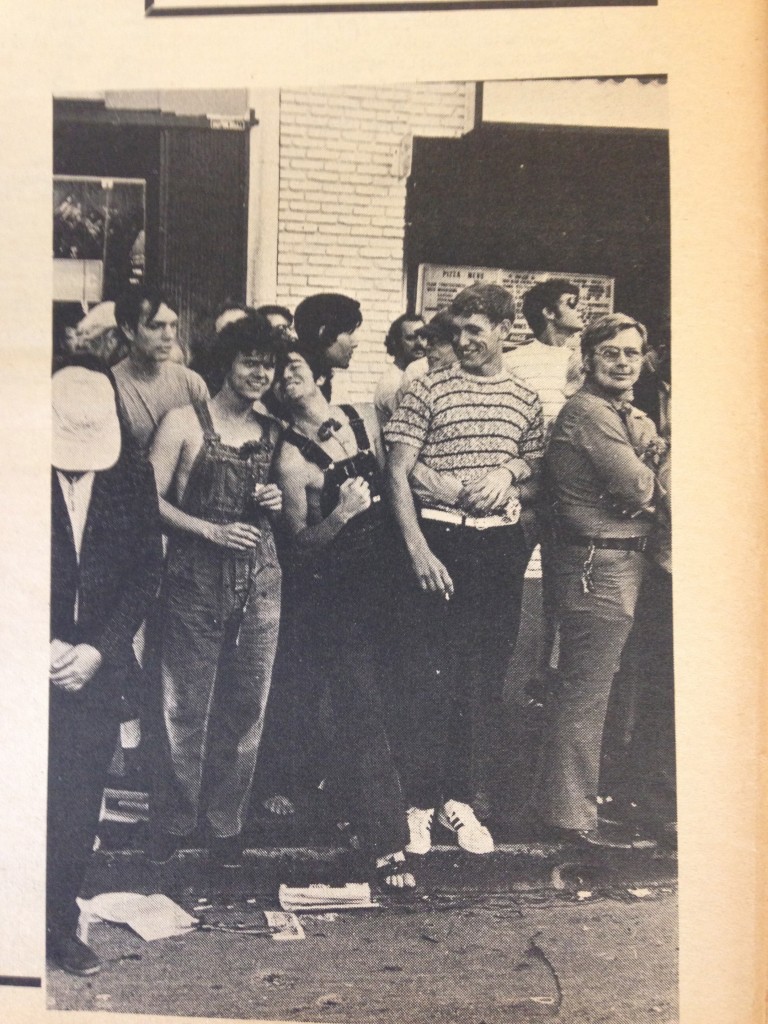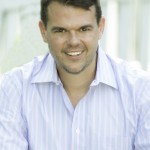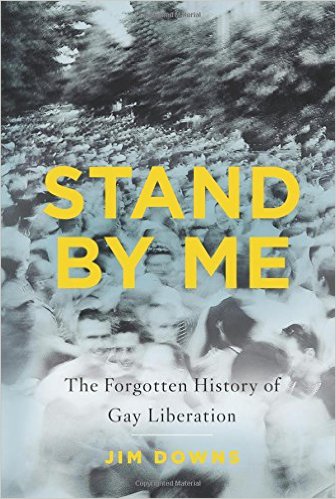Interview by Rachel Hope Cleves
While attending Gay American History @40, a conference held this past May to celebrate the 40th anniversary of Jonathan Ned Katz’s Gay American History, I took a walk with Jim Downs and interviewed him about his new book, Stand By Me: The Forgotten History of Gay Liberation. The circumstances felt propitious. Downs’ book focuses on the 1970s and devotes an entire chapter of Stand By Me on Katz’s work. In addition, several other figures who appear in Stand By Me, including John D’Emilio and Jeffrey Escoffier, were among the speakers and attendees at the conference. At moments during the conference, the 1970s felt less like history and more like the present (as I reported previously). Downs, inevitably, got caught in the cross-fire. Thus I thought it made sense to begin the interview by asking Downs, whose previous book focused on the nineteenth century, how it felt to jump into the history of a time period whose subjects could talk back to him.
Rachel Hope Cleves: As a child of the 1970s, how did it feel to write this book?
Jim Downs: Very comforting and familiar. Coming out in the early 90s I would hear about gay history from people in the community, especially in Provincetown, where I lived the summer after college when it was still affordable for college students to reside there. I developed a nostalgia for the 70s, in the sense that it seemed there were more ways of being gay back then. There were thriving gay intellectual circles and churches. In the 70s you could walk into a gay man’s house and find newspapers and magazines. I felt an attraction to this intellectual world. I found it inspiring. It was empowering to see the work that was done by scholars outside the academy, like Jonathan Katz, was being read by those in the academy and in the gay community.
When I decided to write this book, my training as a nineteenth-century historian gave me an invaluable perspective on the richness of the sources on the 1970s. I was used to the scratching work of trying to reconstruct nineteenth-century African-American history, so I recognized that the newspaper and magazine sources of the 1970s weren’t just timeless artifacts, but evidence of a cultural moment. That’s why I wrote a chapter on The Body Politic, a gay newspaper founded in 1971. From a nineteenth-century point of view, I could connect The Body Politic to a history of reformist movements, like abolitionism and women’s rights, that created and depended on print culture.
RHC: Can you give readers a summary of the book? Tell me about the title.
JD: The initial title was “More Than Just Sex,” which was the organizing principle behind the book. Within popular memory, the history of gay life in the 70s is often refracted through the lens of the arrival of the HIV/AIDS epidemic in the 1980s. As I mention in the introduction to the book, this was the point of the popular 2005 documentary “Gay Sex in the 70s,” and it seemed to be a commonly held view embraced by many non-academics. That is to say, in order to explain the origin of HIV, public health officials, doctors, journalists, and gay men themselves often pointed to the sexual libertine world of the 1970s, and in the process, the emphasis on sex overshadowed other key hallmarks of the period.
As a historian, I wanted to explain to a larger public that the 1970s was much more than a decade about sex. I wanted to explain how the 1970s led to an intellectual, cultural, and religious revolution. LGBT people published thousands of newspapers; they wrote even more articles and pamphlets. They established religious organizations and churches. The mythos of the sex-fueled seventies obscures the intellectual, cultural, and religious contributions of the era. I later chose the title Stand By Me since it evoked the pop song “United We Stand” sung by the gay men gathered for worship at the Up Stairs Lounge on the evening of June 24, 1973, when the largest massacre of gay people in American history took place (the subject of Chapter 1). The book is about how gay men stood by each other to create community in a variety of spheres, not just through sex, during the 1970s.
RHC: Gay culture is a big theme of the book. What does that term mean?
JD: The concept of “gay culture” gave me a way to capture what was going on in the 70s outside of politics. It served as an umbrella term for religion, literature, the body, newspapers, and history. We already know a lot about the politics of the 70s. We take for granted that people came out of the closet and had sex with each other. But what buttressed that? I argue that gay culture became the idiom and foundation that allowed for homosexuality to have a place in the world. Of course, there were antecedents before the 70s. But after Stonewall, the world changed. I resist the academic narrative that Stonewall didn’t really matter. It led to the proliferation of churches and newspapers.
Today, there is a sense that gay culture is being lost, especially among some in the older generation of lesbian feminists. There is a materiality to this change, as gay bookstores shut down, for example. Some of the drive among young gay men and even older generations of gay men is a strong disavowal of a distinct gay culture. In the 70s, gay people fought for that distinction and created their own bookstores, newspapers, and other social and cultural outlets

RHC: Your chapter on The Body Politic includes a section on the conflict over pedophilia within gay male culture during the 1970s. How did you deal with this extremely difficult subject?
JD: At first, I was worried to write about it. Doing the research, I put together the story sporadically. I thought about ignoring it because it was too horrifying. But then my friend, another historian, said it was unethical not to talk about it. After I wrote the first draft of the book, my editor thought I was too harsh on Gerald Hannon, who wrote an article for the paper defending pedophilia. I had to scale it back. Since I did the research, The Body Politic has become available online, but the Hannon article has been erased. I think historians have missed the debate over pedophilia because we’re so focused on creating an origin narrative for HIV. The pro-sex vs. anti-sex debates captured in the historiography were lesser than the internal debate over pedophilia. As a result of Hannon’s article, The Body Politic became ensnarled in a legal fight that destroyed its financial wherewithal. Craig Rodwell, Jonathan Katz, and Martin Duberman all signed petitions or held fundraisers to support The Body Politic. The debate was deeply troubling, but it sewed together various figures in my story, and that fascinated me.
RHC: You caught some flak at the conference for not including women’s history within Stand By Me. How do you respond to that criticism?
JD: My book is about correcting an image of gay men in the 1970s that mythologizes their sexuality in order to explain HIV. That’s not inherently or directly a story about lesbianism. That said, Lesbians and lesbian-feminists do appear in the book, but I didn’t want to just tack on a lesbian chapter to the project. I didn’t want to do a gay man’s version of lesbian history. There are different patterns and rhythms to women’s history. Any time I saw women or feminism influencing the narrative I included it. For example, I explain how Jonathan Ned Katz was influenced by the historian Mary Ryan, and by feminist thought more generally. But I really wanted to explore the development of gay male culture in particular because it has been obfuscated by the emphasis on sex. Many have written about how lesbians in the 1970s separated themselves from gay men and began thinking of themselves as a body politic. But that narrative has been less clear for gay men. It’s not surprising to hear that women gathered in a room and talked about a book. But it’s less well known that men would gather in a room and discuss a book and not have sex. I wanted to focus on forgotten chapters in the history of gay liberation. That’s why I didn’t include a chapter on sex (although Fag Rag, another gay newspaper, offers a great archive of changing sexual culture in the 1970s). Instead I included a chapter on prison reform. My chapter on LGBT people’s critique of mass incarceration in the 1970s shows that there is so much about the 1970s we don’t know. And if I was going to include another chapter, it probably would have been on the influence of socialism and Marxism on gay thought, and really tracking that.
RHC: Stand By Me is published by Basic Books, a trade press. How did writing for a broad audience shape your narrative choices?
JD: Trade books have to be broader. If Stand By Me was an academic book, I may have just focused on religion. As a trade book, a chapter on religion works to open up the discussion. The same holds true for the chapter on how many gay men began to strive for more muscular bodies, which could be a full academic book. I wanted to acknowledge how gay men developed different bodily aesthetics that changed over time. Writing for a broader audience, I wanted to show gay men today how their decisions about going to the gym are shaped by history. Before the 70s, taking off your shirt and being muscular was seen as straight. Then a change took place. Gay men in the 1970s no longer thought of themselves as weak or sinful, and began to embrace a new version of masculinity. The well-developed physique also became a way to read other men as gay. Writing for a trade press also led me to focus on particular stories to demonstrate my argument and to give a face to the many claims that I was making. Rather than write about the gay press at large I focused on one newspaper, The Body Politic, because it allowed me to tell the story from its inception to its demise. Rather than write about all gay bookstores I focused on Craig Rodwell’s Oscar Wilde Memorial Bookshop. Focusing on stories enabled me to link chapter to chapter, for example by introducing Katz as a shopper at Rodwell’s bookstore.
RHC: Speaking of which, we need to hurry to get back to the conference for the next panel. There’s a session on early American histories that I don’t want to miss! Thanks for taking the time to talk with me.
JD: My pleasure!
 Rachel Hope Cleves is a Professor of History at the University of Victoria in British Columbia. She specializes in early American history and has written about the history of same-sex marriage and about American reactions to the French Revolution. Her most recent book is Charity and Sylvia: A Same-Sex Marriage in Early America (Oxford University Press, 2014). She is presently at work on a book project titled “Good Food, Bad Sex.” You can follow her on twitter @RachelCleves.
Rachel Hope Cleves is a Professor of History at the University of Victoria in British Columbia. She specializes in early American history and has written about the history of same-sex marriage and about American reactions to the French Revolution. Her most recent book is Charity and Sylvia: A Same-Sex Marriage in Early America (Oxford University Press, 2014). She is presently at work on a book project titled “Good Food, Bad Sex.” You can follow her on twitter @RachelCleves.
 Jim Downs is an Associate Professor of History at Connecticut College where he specializes in nineteenth-century US history, African-American studies, and the history of medicine and public health. He is the author of two books: Stand by Me: The Forgotten History of Gay Liberation (Basic Books, 2016) and Sick from Freedom: African-American Illnesses and Suffering during the Civil War and Reconstruction (Oxford University Press, 2012). During the 2015-2016 academic year, Downs is an Andrew W. Mellon New Directions Fellow at Harvard University.
Jim Downs is an Associate Professor of History at Connecticut College where he specializes in nineteenth-century US history, African-American studies, and the history of medicine and public health. He is the author of two books: Stand by Me: The Forgotten History of Gay Liberation (Basic Books, 2016) and Sick from Freedom: African-American Illnesses and Suffering during the Civil War and Reconstruction (Oxford University Press, 2012). During the 2015-2016 academic year, Downs is an Andrew W. Mellon New Directions Fellow at Harvard University.

NOTCHES: (re)marks on the history of sexuality is licensed under a Creative Commons Attribution-NonCommercial-NoDerivatives 4.0 International License.
Based on a work at www.notchesblog.com.
For permission to publish any NOTCHES post in whole or in part please contact the editors at NotchesBlog@gmail.com





